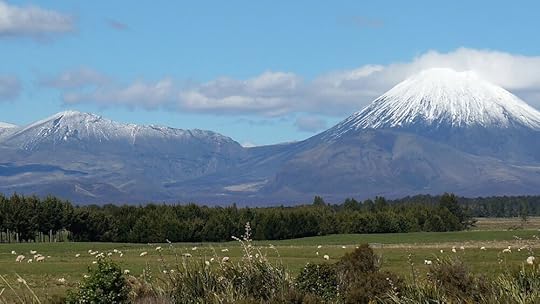Tim Sweeney's Blog
July 2, 2023
Book Excerpt: Melbourne Spring Carnival
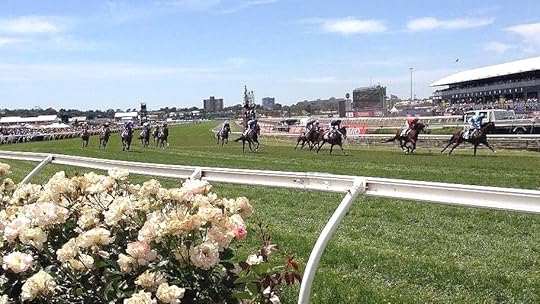
The following is an excerpt from the Melbourne chapter of my new book, Yank Down Under: A Drink and a Look Around Australia.
The dapperly attired young man in the queue ahead of me is in a sparring match with the ticket vending machine that I am waiting to use here at Flinders Street Station in Melbourne. I’m not sure what the problem is. I’ve bought my train tickets here before and it never felt like I needed an algorithm to solve it. But old mate looks to be a few beers deep, despite the fact that it’s 11:30 a.m., and that could be the source of the holdup. To the right, a group of his mates are good-naturedly urging him to get his shit together. I know this because they are yelling things like, “Get your shit together, mate!”
All, except one, are dressed in suits that fit just a bit too tight, as is the custom in Australia. The odd man out is wearing a dress, a woman’s wig, and lipstick. Either he didn’t get the memo or he’s the lucky bloke getting married and this is his bucks day. Across the way, a flock of twenty-something women are dressed to the nines in high heels, fancy hats, and dresses you might see at a summer wedding.
Today is the first Saturday in November and that means it’s Victoria Derby Day, which will kick off Melbourne’s Spring Carnival of thoroughbred racing at Flemington racecourse, six kilometers northeast of the Melbourne CBD. The Melbourne Spring Racing Carnival carries on throughout the spring, as the name might imply to those of you familiar with the seasons of the year, and people come from across the land, and many faraway lands, to experience it. It’s also a shit show, as the brunch-time scene at the train station might have foreshadowed.
The Melbourne Cup, which will happen on the coming Tuesday, is billed as The Race that Stops a Nation because it actually does bring Australia to a halt. In the state of Victoria, Cup Day is a public holiday. People have the day off from work because a group of equine quadrupeds partake in a three-minute race. Across the country, people stop what they’re doing—even schoolchildren, I’m told—to watch and have a punt (wager) on the race when it goes off at 3 p.m. The Melbourne Cup draws somewhere around 100,000 people to Flemington, even in the rain. Two days later, Oaks Day (on Thursday) draws another 70,000-plus and is the traditional Ladies’ Day at Flemington, though it has jokingly become known as Blokes Day because if it’s ladies’ day, well, yeah, the men of Melbourne are no dummies. Each of these big days on the calendar—Derby Day, Cup Day, and Oaks Day—feature myriad fashion shows and judged competitions for best-dressed attendees, none of which were likely to include the bachelor from the train station.
Five years earlier I spent my very first weekend in Melbourne attending Derby Day with Leighton and some of his mates in a biblical rainstorm that left my shiny black shoes as caked in mud as those on the horses. Despite the rain, the day was a blast, and so was the night that followed. It was a hell of a way to be introduced to Melbourne. Leading up to that first Derby Day experience, Leighton had described the Spring Carnival as “fishing in an aquarium” for single people, and if a more Australian thing has ever been said, I’d like to hear it. Shakespearean prose there from the man who likes to call himself The Wiz.
As I marched into Flemington on that rainy day with 80,000 other well-appointed and reasonably well-behaved (for now) individuals, I remember thinking that I was about to attend the biggest party of my life…all day long…and well into the night, if I could manage. And this proved to be the case. In horse racing parlance, it’s good to be a stayer on days like this. Thankfully, this is one of my talents.
Today, on a partly cloudy but perfectly acceptable Melbourne spring day, we are doing it again—me for the fifth time; Leighton for the umpteenth. As wily veterans of the Carnival, the scene at Flinders Station hardly raised an eyebrow as we boarded the train to Flemington dressed in the traditional Derby Day black and white.
There are a number of ways to enjoy a big racing day at Flemington, and I have been fortunate enough to try most of them. You can get a pass to one of the exclusive branded “marquees” in an area called the Birdcage, where you will drink free alcohol, nibble on fancy canapés (hors d’oeuvres), and watch the beautiful and famous people move about these temporary daytime nightclubs. Or you can get a highly sought-after ticket to sit in the grandstand and watch like a real horse racing fan who studied the racing form the night before. Or you can watch the ponies along the rails until some of the people around you are using the rails to keep themselves vertical.
Or you can do what we are doing today: buy a ticket that gets you into a giant grass car park where you will watch the racing on video screens with the masses. This assumes you have a mate who is kind and dedicated enough to leave home at some absurd morning hour to drive to Flemington and park in his or her reserved spot, thereby hauling all of the food, booze, and whatever else you might want for the day. It turns out, our colleague Matt Sullivan is just such a mate.
Heading into the day, the car park tailgating plan sounded like going to a football game in the US and never going into the stadium or attending a concert and then watching the show on a video screen completely out of view of the stage. As it turns out, spending Derby Day tailgating in a suit and tie while watching horse racing on a video screen a few hundred meters from the track itself is surprisingly fantastic. And even if it’s not, don’t worry; the first time you go to the Spring Carnival, you aren’t likely to remember all of it anyway.
Click here to purchase Yank Down Under: A Drink and A Look Around Australia
May 30, 2023
Long weekend in Edinburgh, Scotland
A quick recap of a great long weekend in Edinburgh, Scotland, with a one-day drive out along Loch Lomond..with a “wee, small” hike.
🥃 Whiskey flights at the Devil’s Advocate in Edinburgh.
🏰 Doune Castle, where Monty Python and Game of Thrones have been filmed
⚽️ A Saturday afternoon soccer match at Hearts of Midlothian’s Tynecastle Park in Edinburgh.
🎵 Live, late-night tunes and Guinness pints at the Royal Oak Pub, which is about the size of your bedroom (if your bedroom is really small)
🐕 A little pet of Greyfriars “Bobby”, a statue of the dog who guarded the grave of his owner for 14 years until he went to doggie heaven in 1872.
🥾 A little hike above the shores of Loch Lomond 🏔️
🏌️♂️ Golf at Old Musselburgh Golf Course, which is set on the grounds of a horse racing track. Scots have been playing golf here for 350 years, making it the oldest continuously played course in the world.
View this post on InstagramA post shared by Tim Sweeney (@tesweens)
A long weekend in Edinburgh
August 31, 2021
A Weekend in Prague
View this post on InstagramA post shared by Tim Sweeney (@tesweens)
I don’t know why, but for a long time, I’ve wanted to go to Prague. Here’s a quick look at what a weekend in Prague, Czech Republic looks like if a bartender from Macedonia (who has lived in Prague for a decade) gives you a bunch if tips on night one while serving you pints of Guinness. Whoever that guy was, thanks!
August 21, 2021
Hiking above Courmayeur, Italy
View this post on InstagramA post shared by Tim Sweeney (@tesweens)
In August, I drove 90 minutes over to Courmayeur, the swanky ski village on the Italian side of the Mont Blanc, or Monte Bianco, as they call it in Italy. Courmayeur is about 25 minutes from Chamonix, France, through an 11.6 km (or 7.2-mile) long tunnel. This hike started at the church in town, then travelled up from the village through some nearby neighborhoods before hopping off the road and onto a trail. Eventually, it connects with the TMB (Tour du Mont Blanc) Trail. In all, it was 25 kms (15 miles) and 1,646 meters (5,400 feet) in elevation. It took just over six hours. The pasta and beer at the end was well-earned.
August 1, 2020
A Taxi Ride in Rome
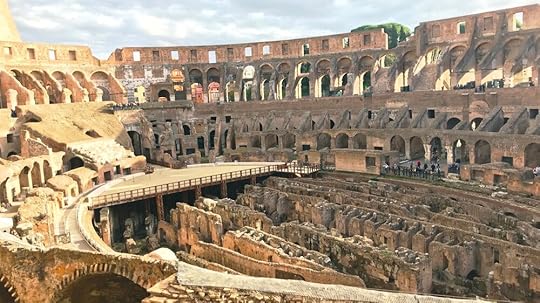
The massively overweight Italian taxi driver with my life in his hands—or, more specifically, in one of his hands—is talking to me now in Italian in an increasingly animated manner. He’s doing this despite the fact that we have established quite clearly minutes earlier at Rome’s Fiumiciono Airport that I know zero Italian and that his English “is a notta so goodah.” While using one arm to swerve deftly between cars at 80 miles per hour and the other to stretch relaxedly across the top of the empty passenger seat in front of me, he is verbally chastising every driver he cuts off on the roadway. You might say he is driving like an Italian taxi driver.
His anger toward other drivers contrasts curiously with what seems to be a strange affinity for soft American ballads that would fit perfectly on the Dirty Dancing soundtrack. Even better: he’s blasting these tunes on the outdated car stereo like a 17-year-old driving through the high school parking lot. A few minutes later, I think he is offering me a cigarette.
“No, thank you. I don’t smoke,” I say.
“No. I a-want to a-smokah. You have a problem if I a-smokah?”
I hate cigarette smoke, but self-preservation prevails. “Not if it calms you down, nope. Smoke away.”
And so he smokes, but only after rolling his window down for me. Then he begins to snore…except he’s awake. Or maybe he’s just trying to breathe. I can’t tell. A new song comes on with a chorus of “I LOVE MY LIFE” and I contemplate the irony of dying while listening to it. His driving style is to go as fast as he can at the bumper of the car in front of him until he or she moves to the right. Then do that to the next car, presumably until all cars are gone from the face of the earth. All the while, he’s talking incessantly in Italian. Living in France, no stranger has spoken to me this much in the last 18 months.
At this moment I remember my mother telling me about my parents’ trip to Italy. To let their group cross the street, the tour guide walked into the middle of traffic and waved with his newspaper at the oncoming cars to slow down. That would not have worked on my chauffeur; he would have stepped on the gas and aimed for the front page of the sports section.
Still, he’s a nice guy. He slows down in a couple of spots to show me a view of St. Peter’s Basilica, and he even apologizes to me when we have a road rage incident with a pedestrian he almost hits who then chases us down the street.
“Sorry about that a-sir. Enjoy a-Roma.”
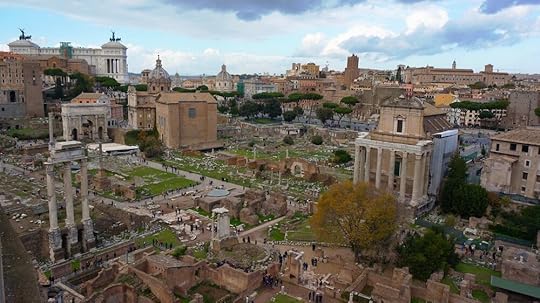
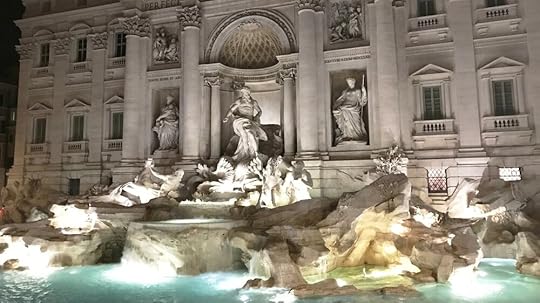
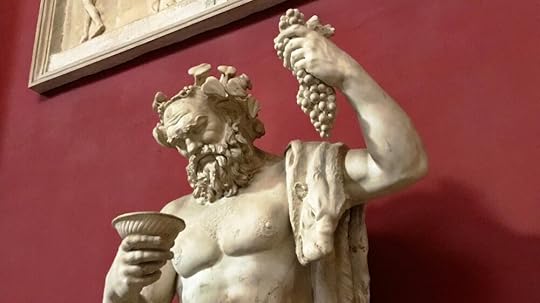
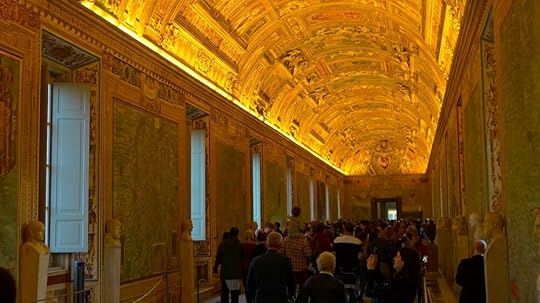
July 15, 2020
A Weekend in Dublin
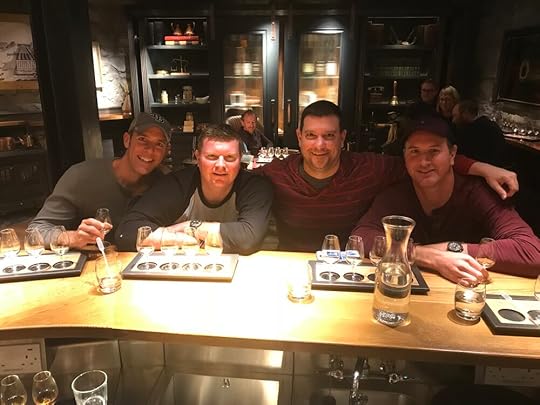
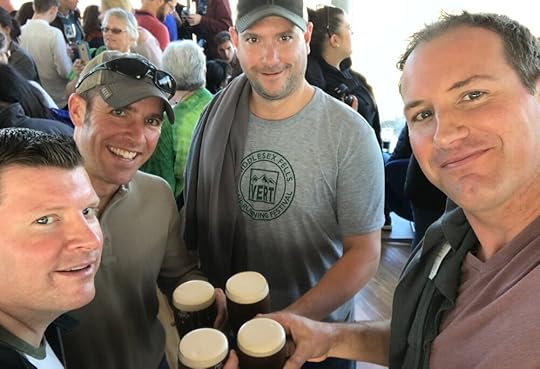

“A little piece of trivia for you, folks,” begins the Santa Claus-looking tour bus driver as we pull away from St. Patrick’s Cathedral in Dublin. “This cemetery just on the left is where the inventor of the crossword puzzle is buried. You can take a walk through and find his grave. He’s buried at 4-down…and 3 across.” On and on the jokes went as we crisscrossed the River Liffey in the double-decker bus, the old-timer setting them up and knocking them down with the comedic timing of Rodney Dangerfield and the oratory aplomb of Winston Churchill.
“This is the The Anna Livia fountain and statue, though some call her the Skank in the Tank or the Floozie in the Jacuzzi.” Boom!
“What do you call a North Dubliner in a suit outside the courthouse?” said the man from South Dublin. “The defendant!” Badda-ba-chiing!
Of all the things to love about Ireland—and Dublin in particular—the simple feeling that its inhabitants WANT you to have a good time when you visit is at the top of the list. Bartenders will advise you to leave their bar—even when you are quite comfortable on one of their barstools—and go to another one with great live music. (Or maybe they just wanted us to leave.) A taxi driver will tell you where to go, what to avoid and how he once took middle-aged American U2 fans to find Bono’s house and secondary school. Policemen will even tell your brother where to find a bar that’s still open.
I didn’t go to see U2 or even the local playground where they played as kids. Anyway, they were probably on their yachts in the south of France. I went to rendezvous with my brother, the guy who asked the cops where to find an open bar, and two other American friends for a weekend of, well, laughs. And you seem to laugh a lot when you’re in Dublin. The trip also included a few tourist activities and a fantastic Jason Isbell concert at the138-year-old Olympia Theater, which might just have the best acoustics of any venue I’ve ever been to.
Inevitably, each activity meandered toward something that involved Guinness because, well, when in Ireland… And yes, Guinness should be enjoyed cold and it tastes much better in the homeland. I know because we tried all of it. (Don’t worry; they’re making more.)
We spent three hours on Friday afternoon at the Guinness Brewery at St. James’ Gate, where you can meet people from around the world at the seventh floor Gravity Bar, where the tour concludes …and seems to continue on for some time. The bar was bathed in “brilliant” sunshine the day we visited and it offers panoramic views of the city and even out to the Irish Sea and the Wicklow Mountains in the distance. Because we were on a roll, the next day we hopped back on the tour bus and dismounted at the tasting room of Jamison’s Irish Whiskey, an experience that was educational, entertaining and a little warm and fuzzy by the end. If you’re sensing a theme here, you’re sensing correctly.
The highlight of the trip was the show by Isbell. If you don’t know him and you like great lyrics and guitar, do yourself (and him) a favor and start listening. He and his band the 400 Unit were even better live than I hoped, and my expectations were high.
Besides the hospitality, the next best thing about Ireland is that they serve potatoes with everything. Even the personable 30-something clerk at St. Patrick’s Cathedral gift shop, where I bought a book called “Irish Potato Recipes” (because that’s where you buy a potato cookbook), blamed his mother’s spud-based dishes for the growth of his waistline upon returning from a stint living overseas. What was less surprising than the fact that he was 35 years old and living at home was that he also dropped F-bombs into the conversation with surprisingly regularity for a guy who was, you know, WORKING INSIDE A GIANT CHURCH!
On our final full day in Dublin, we escaped the city for a two-hour hike along the coastal trails of Howth, a small town a few miles north of the city where last night’s Guinness and Jamison seem to flow freely from your pores on the up-hills. The sun was shining, the views were spectacular and guess what goes well with the end of a hike? Mmmm Guinness.
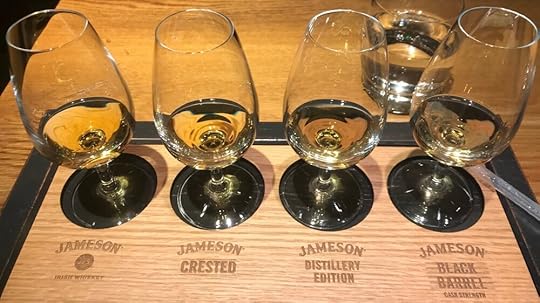
May 14, 2020
Life Lessons in a Baseball Bat
A few years ago, I wrote this short Father’s Day story on my old website. I got all kinds of messages back from people who said it struck a nerve, so I thought I’d share it here, on the new site.
When I was 10 years old, I asked my father for a new aluminum baseball bat that I’d been eyeing for weeks at the local sporting goods store. Since this was obviously a long time ago—depressingly long ago, in fact—it would be reasonable to wonder why I would remember this bat. It was royal blue with white stars down the barrel and the words “All-Star” in large white, stenciled letters. Trust me, this bat was sexy.
As dashing as it was, the bat was too big and too heavy for me at the time. My father told me so each time we went into the store, while also pointing out the rather excessive price tag attached to it, as dads often do. Nevertheless, I was enamored with how cool it looked as well as the potential damage I could do with it on the diamond….but mostly how cool it looked. Given my father’s repeated protests in the weeks before, I was stunned to find the bat leaning on the coffee table on Easter Sunday morning. There it was, right next to my Easter basket with my annual allotment of Hershey’s Kisses and Peeps, the latter of which I still don’t like and always gave to my younger brother.
Excited about my marquee Easter gift, and with Little League baseball season getting into full swing, I convinced my father to take us to a local baseball diamond later that morning. Following our post-church trip to Dunkin Donuts (the reward for good church behavior), Chris and I quickly changed out of what was likely some sort of Easter Sunday matching blue blazers and khaki slacks into something sportier, including our bright white turf shoes. (Turf shoes were pretty cool in those days.)
While mom fixed another delectable Easter dinner, the three of us trekked off to the local field, hopped the fence by the locked gate and took batting practice for an hour. I managed to connect on a few of Dad’s pitches thanks to him aiming for the barrel of my new bat. In the outfield, Chris was busy chasing baseballs in all directions on a sunny, but brisk morning. Despite a few swings, it was evident that the bat was too heavy for me, just as my father told me it would be. The lesson, as I would learn much later (after fervently disagreeing with it during my teenage years): Dad is always right.
Somewhat frustrated that my new toy—the one I was so in love with just minutes earlier—was too big and heavy for me, I traded places with my brother and shagged balls for him for a while. I didn’t want to admit it, but I stood in the outfield realizing that I’d fallen in love with the look of the bat, not what I could do with it. When I should have been concerned with function, I’d been blinded by form. And with dad, the choice between style and substance was always an easy one.
Reluctantly, I put the bat in the closet and it didn’t become my “gamer” for another year, when I was strong enough to swing it. Then, when other players on the team wanted to use it, my father (who was also the coach) made me share it. We were a team, he told me. Reluctantly, I learned to deal with the white blemishes that appeared on my blue bat every time someone used it. Over time, I even felt some pride when it played a role their success.
When I angrily threw the bat because I struck out, he told me in no uncertain terms not to do it ever again. Judging by our on-course golf demeanors, this is was more of a do-as-I-say-not-as-I-do type of lesson.
A couple of years later, when the bat became too small and too light for me and my brother, my father drilled a hole in the bottom of it, filled it with sand, then plugged the hole. It was now my weighted warm-up bat to help me quicken my swing. There was still value to be found in something if you looked for it.
When I consulted with my parents about moving to California, then to Australia, and then to France, they encouraged me to take advantage of every opportunity I had. That can’t be easy for parents to do, but it was enormously appreciated. My dad (like my mother) beat cancer thanks to the marvels of modern medicine, some great doctors and because he was just stubborn and tough enough to do it. His lawn has always been the best in the neighborhood and he and has long been the best source I know for advice and counsel.
Normally, he would be the first set of eyes on anything I write because of some very capable editing skills and his willingness to deliver honest feedback. Because I live so far away and because he always says, “Tim, I don’t need any gifts,” all he got this Father’s Day was this old tale about a blue baseball bat. Thanks, dad, for the sexy blue bat, the teachings (intentional and unintentional) that came with it, and the countless others I probably never noticed along the way.
My dad passed away in 2018. In this hidden post, I shared the words I wrote and said about him at that time. If you came this far, maybe you’d like to hear about who he was to me.
May 1, 2020
Horseplay in New Zealand
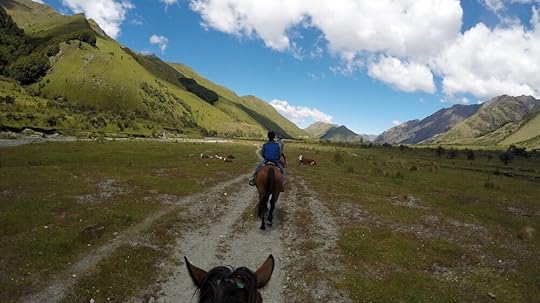
There’s a huge, four-year-old Clydesdale named Ben who plies his trade on a ridiculously scenic horseback riding station outside Queenstown, New Zealand. Ben loves to eat…anything. Ben also enjoys stopping for drinks at stream crossings and is quite perturbed by flies buzzing around his head (but who isn’t?). His best friend—or mate, as they say in these parts—is a former racehorse named George. I know all of this because I spent two hours aboard Ben on the first horseback ride of my life. Can you even be “aboard” a horse? Doesn’t matter.
Anyway, prior to this occasion, the closest I’d come to horses was wagering on them at a handful of thoroughbred tracks in the U.S. and Australia. Well, that and the mechanical bull we rode the previous afternoon after 2 whiskeys on the rocks and two beers before 3 p.m. I’ve always found horses fascinating, though. Up close, they are enormously strong, beautiful animals. The fact that humans can train them to carry them around or run fast so people win money is astounding to me. If you tried that with, say, a tiger, it would end differently.
Ever since watching Billy Crystal in “City Slickers” as a kid, I thought doing one of those regular-people-go-be-cowboys-for-a-week things would be cool. Without an entire week to spare and no midlife crisis upon me, the two-hour variety seemed like the sensible option. So with a handful of brochures staring back at us from the wall of our hotel lobby, my college buddy Andre and I decided to take a one-day break from jumping down river canyons or climbing large mountains and give cowboying a shot.
It wasn’t easy finding a partner like Ben. Due to my size (weight), I was shot down by several outfits in the Queenstown area. “Sorry, Tim, but we don’t have a horse for someone your size,” the emails said. Having been made to feel like a fatty, these responses only strengthened my resolve to find a match… of the equine variety, I mean. Finally, a very nice woman named Kelly Duncan, who operates Ben Lomond Horse Treks with her husband, replied with good news: “Yes we do have one horse who can happily take you,” Kelly wrote. “Ben, our big Clydesdale, is lovely. Very kind and gentle, but he is only a walking horse.”
Only a walking horse? What was she expecting I wanted to do? I had no visions of anyone yelling, “Annnnd DOWN the stretch they come in the Derby!” as Ben and I headed for home. I didn’t need Seabiscuit; I needed Mr. Ed. Plus, Ben was a Clydesdale. There was a 75 percent chance he would lead me to a stash of Budweiser in a cold mountain stream, right?
Ben Lomond Station sits in a beautiful valley beside Moke Lake, up a long dirt road about 15 km outside Queenstown. They could film a Western here. It is absolutely stunning, with green hillsides and mountains rising sharply above. If you were going to go for a horseback ride once, this would be the place to do it. Admittedly, it would be a long way to go if you were not already in New Zealand.
Upon arrival, we hopped inside the fence and said hello to the all-female crew that handles the day-to-day operations of the place (and that part wasn’t even planned). Kelly introduced us to Anna, a lovely young woman from Germany who would be our guide, responsible for taking us on our 90-minute trek and preventing this from happening. She didn’t know it yet, but outside of Ben, Anna would be my best friend for the next 90 minutes. She spent a few minutes explaining the ins and outs of riding a horse—mounting them, turning them, how to sit up when they stopped to relieve themselves, and explaining quite clearly that they were not to eat anything out on the trail. (You’ll want to make note of that last item.)
Andre would be riding George, the 13-year-old former thoroughbred who looked like he’d been doing a bit more dining than dashing in his retirement years. Ben and George, Anna told us, were best friends. “They are inseparable, so they’ll enjoy being out there together and they are two of our best horses,” she said. “They’re very well behaved. It will be easy.” Famous Last Words alert there.
We departed the stable area and made our way along a dirt road at a slow comfy amble. Ben and I followed closely behind Anna and her horse, with Andre and George in the back. Three minutes in, for no reason that I could decipher, Ben decided to make a u-turn and head back in the opposite direct as George and Andre went sauntering by laughing. Well, Andre was laughing for sure. George probably was, too. It seems Ben’s attention was grabbed by a few pieces of hay that had been inadvertently dropped along the trail. It was like someone leaving a slice of pizza on the table in a college dorm room at midnight. It won’t last long, and the Five Second Rule does not apply to hay. Ever heard a very inexperienced rider try to reason with a 1,700-pound horse? It sounds like this:
“Where are you going, Ben?”
“What are you doing, Ben?”
“No. Wrong way, Ben.”
“You’re not supposed to eat that, Ben.”
(Notice there is no reply there.)
With Anna shouting directions to “pull him up” and get him on his way, I did my best to use the reins to turn him around and give him a slight pinch of my left leg to get him turning right, as previously instructed. My verbal pleading would have made John Wayne and Sam Elliot proud: “Coooome onnn, Bennn! Puhleeease. Let’s not do this today, buddy.” Which sounds almost as cool as: “I have two guns. One for each of you” and “I’m your Huckleberry.” Yeah, I could be in Tombstone II if they make one (which they absolutely should not do).
After the hay was digested we were off again, winding onto a beautiful trail through a working farm. Along the way we came across cattle, sheep and other animals sitting alongside the trail and looking curiously at us as we strolled by. We crossed several small streams, each of which Ben used for a drink break that put us farther behind Anna and Andre, who were now happily chatting away while I talked to Ben and patted his neck oblivious to the fact that I am allergic to horses. (Bloodshot, itchy eyes and a 15 sneezes would soon follow, but it was nothing that couldn’t be dealt with.) Ben seemed to know he was losing ground because he took shortcuts across the grass whenever the path made a wide turn, clearly aware of the direction the party was headed. No use walking those extra 12 steps along the trail itself, Ben. By all means, whatever’s easiest.
Anna would later tell me that Ben is in his teenage years as horses go, meaning he loves to eat and can have a mind of his own at times. Hard to fault him for those traits. “I am still bemused by Ben!!” Kelly later told me by email. “Very out of character for him, but I guess that's why they say kids and animals always turn you into a liar! So sorry that he was taking you on ‘his own’ tour.”
Not to worry at all, Kelly. Ben made a great day even more entertaining. And he would save his best performance for last. About 300 yards from home, George pulled up quickly to deposit a large pile of something you would not want to step in (because you’d never see your shoe again) on the ground. Ben and I nearly walked into him. Instead, after George went on his way, Ben took three more steps and abruptly made a u-turn to feast on George’s fresh pile. When they said Ben and George were close, they weren’t kidding. I managed to turn him fairly quickly this time and he seemed to be on his way. Then, seemingly sensing that I had settled, he made a second u-turn for another helping of his good mate’s manure. WHO IS THIS GUY? He’s like a damn bull shark. Everything is on the menu.
Overhearing more one-way dialogue between Ben and I, Anna called out from the far end of the paddock.
“What’s he doing, Tim?” I searched for the words before succinctly shouting back, “He’s eating George’s shit!”
Cue the belly laugh from Andre, who by now was telling Anna all about his trip to Oktoberfest in Anna’s homeland and saying whatever else guys with limited “game” say to pretty young German girls. (Is that sonofabitch speaking German to her while my horse eats a steaming pile of shit?)
“Pull him up!” Anna yelled through her own laughter. “You can be firm with him.”
Oh, sure. The guy eating his best mate’s fresh dump cares what I have to say right now.
“He’s not supposed to be eating,” Anna repeated.
“Yes, I recall,” I said. “I didn’t ask him to do it and I can’t imagine what’s he finds appealing about it.”
I took her advice and got firm with the big fella. Soon, we were back in gear and on our way again. Ben took me safely back to the hitching post, where we said our goodbyes…while he ate. Again.
And no, he never showed me the Budweiser stash. Next time, Ben. Next time.
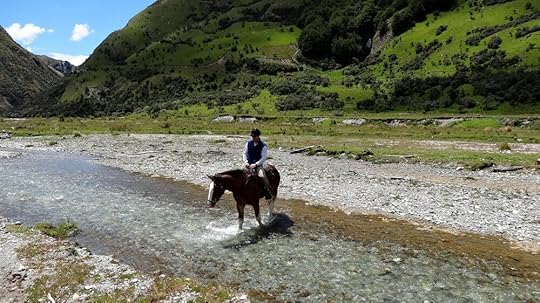
April 1, 2020
Bourgogne, France: Wine Tasting, Soccer and Dijon mustard
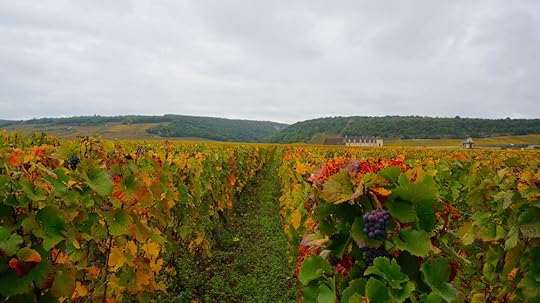
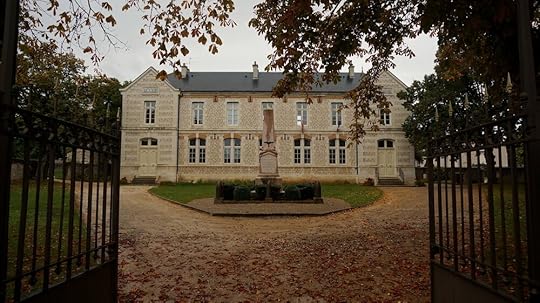
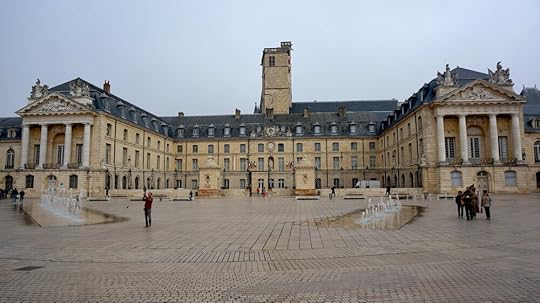
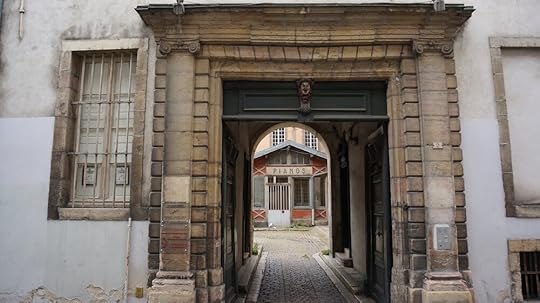
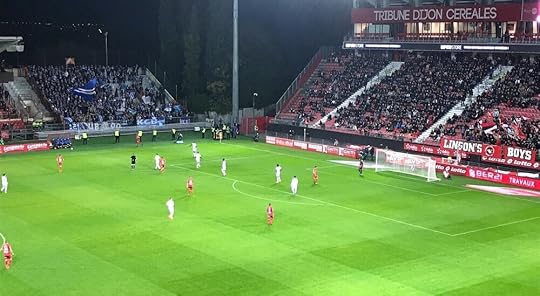
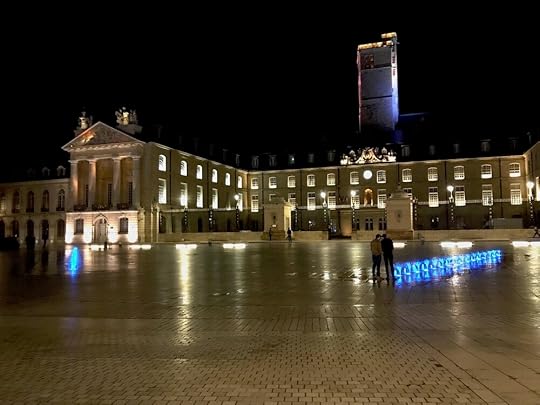
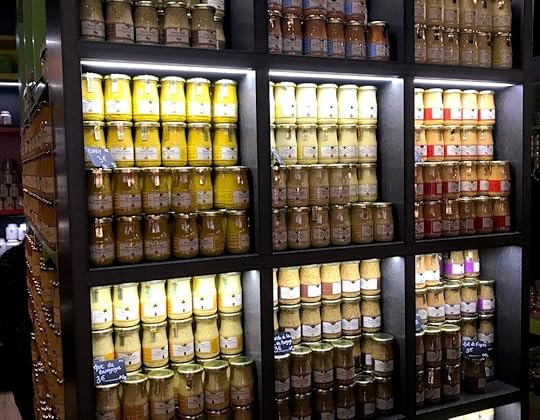
A lit flare has just appeared—and then another and then another—in the small, but raucous section of the stadium housing the visiting supporters from Strasbourg. It’s Saturday night and I’m in Dijon, France, where they make the mustard. And if that’s not a claim to fame, I don’t know what is. I’m watching two of the worst teams in Ligue 1, the top soccer (football, in these parts) division in France. Basically, I’m watching the New York Jets and the Cleveland Browns, with more cigarettes in the crowd.
I’ve made the three-hour drive to the Bourgogne (or Burgundy in English) region of France—of which Dijon is the capital—to drink a little wine, see a couple of old towns and take in the football match between Dijon FCO and Racing Strasbourg, from the Alsace region on the German border. Considering there are only 10,000 or so scarf-adorned Frenchies in attendance on this chilly autumn night, the atmosphere inside the 16,000-seat Gaston Gerard Stadium is electric. Supporters from each side have been singing and chanting nonstop since the game started 30 minutes ago, many of them without shirts. A scarf sans shirt; now there’s a good look!
A few minutes after the third flare was lit, the Strasbourg faithful add a strobe light to the mix. I’m waiting for the Bee Gees to come out for the halftime show. A disco ball can’t be far behind. The game ends in a 1-1 draw and the hometown fans responded with bitter disappointment, launching thousands of tiny bottles of spicy, expensive mustard onto the field turning the grass a dark yellow shade. Not really, but let’s pretend.
A network of canals with river locks crisscross the Bourgogne countryside and, in early October, the rolling hills were filled with the colors of changing leaves on the vines. I drove what’s called the Route des Grand Crus, a 60-kilometer long narrow, one-lane road that cuts in and out of charming quaint villages whose existences seems to revolve around wine. The road is bordered on both sides by vineyards and runs along the foot of the Cote d’Or escarpment, which is a fancy way of saying it runs along the bottom of a hill.
That afternoon, in between stops to taste the wine I’m currently drinking, I made a two-hour visit to the small, scenic city of Beaune, 40 minutes south of Dijon. Beaune is a walkable walled city with a multitude of cafes, wine-themed shops, wine tasting rooms and restaurants. Even in the rain, it’s an interesting and relaxing place for a stroll.
On Sunday morning, a stroll around Dijon revealed a picturesque town with a large square that’s overlooked by the beautiful Palace de Liberation. The city was occupied by the Germans from 1940-1944, but looks much the same as it did during World War II. But with less Germans. The buildings date to medieval times and it feels as though you are walking around on the set of a movie…albeit a movie where everyone is looking down at their phones.
Evidently, Dijon mustard got its start here in 1856 when a guy named Jean Naigeon pulled a little switcheroo on the traditional recipe. Instead of using vinegar, Jean the innovator substituted verjuice, the acidic "green" juice of not-quite-ripe grapes. He would not approve of me putting honey mustard on every Chik-fil-A order I place.
Fittingly, that morning I came upon the only mustard-only store I’ve ever seen—of which Dijon probably has 10—and bought three small jars I’ll probably never open. Even more surprising than the existence of a mustard-only store was the fact that it was open on a Sunday. I think even French hospitals are closed on Sundays. Around noon, I found a brunch spot and stepped inside to find four people eating and 20 unoccupied tables. The place was a ghost town.
“Hello. Do you have a table for one person, please? I would like to have lunch,” I said en Francais, and with a smile.
“Oh, monsieur, do you have a reservation?” he replied, also en Francais.
I paused, glancing at the 20 open tables. “No, monsieur. I do not have a reservation.”
“Oh, I’m sorry. You need a reservation.”
Clearly. Welcome to France.
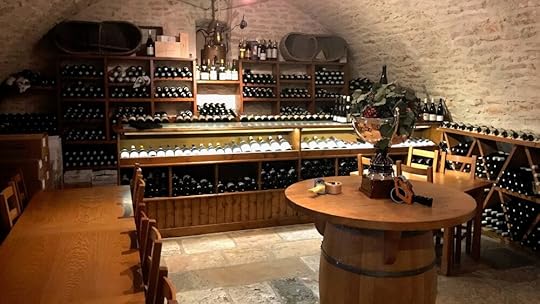
January 11, 2020
Hiking the Tongariro Alpine Crossing in New Zealand
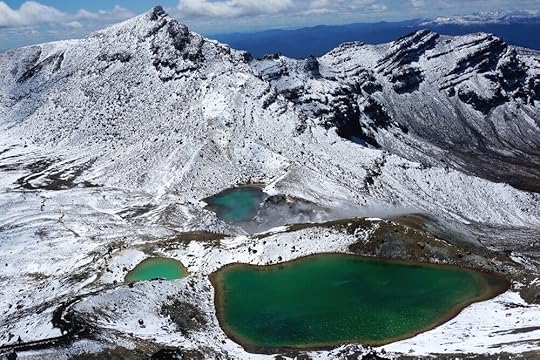
When asked in the early 1920s why he wanted to climb Mount Everest, legendary English mountaineer George Mallory famously replied: “Because it’s there.”
Mallory died on Everest in 1924 and his body was found 75 years later. So, as it turns out, he was “there” awhile himself.
My reasons for undertaking the slightly less challenging Tongarino Alpine Crossing in the center of the North Island of New Zealand were different from Mallory’s… as was my intended fate. The Crossing, as it’s known in New Zealand, was “there” of course, but so was the bed I was sleeping in when the alarm went off at 5 a.m. My buddy Andre and I did The Crossing because his research revealed it to be “the best one-day trek in New Zealand.” Some even say it’s among the top ten single-day treks in the world. I thought that title might belong to the distance between, say, the couch and the bathroom on a Sunday afternoon during football season. Evidently not. Nevertheless, if those titles were bestowed upon it by anyone, it had to be worth a look. It’s also an active volcanic area and we’d never climbed one of those. If it erupted, much excitement would surely ensue.
The Crossing is 19.4 kms (about 12 miles) from one trailhead to the other. It supposedly takes 7-9 hours to complete—though you’d have to be on your hands and knees for it to take 9 hours—and begins a few minutes from a tiny outpost called National Park. The town consists of a few hotels, a couple of bars, a small market, no stoplights that we could find, and a train station that welcomes one passenger train per day, except on Wednesdays when no trains come through. Just keep that in mind if you’re ever looking to ride the rails of New Zealand toward National Park on a Wednesday. After waking in the dark in Taupo along the shores of Lake Taupo, we made the scenic, hour-and-40-minute drive to our hotel in National Park, dropped our bags with the lovely pregnant, pajama-clad woman at the front desk and headed back to the trailhead at the end of a long, climbing dirt road. There, we’d leave our car and commence the walk, hitching a death-defying shuttle ride back to it when we reached the other end.
The Tongariro Alpine Crossing starts at an elevation of 3,670 feet and crests at 6,188 feet. There is hardly any vegetation to be seen. Much of the views are of volcanic rock and the bulk of the walk is quite exposed to the elements. There are no trees to protect visitors from wind, rain or snow. The route itself is unique in that it’s not an up and back down climb, but rather consists of flat areas and a number of climbs and descents along the way. In fact, the last three hours are spent going downhill, which sounds simple unless you’ve done much downhill walking for three hours at a time. Rest assured you’ll feel the downhills more than the uphills the next day.
The oldest lava in the Tongariro area started flowing 300,000 years ago right up until the Ice Age. The youngest volcano in the area formed 2,500 years ago, with its latest eruption coming in 1975. Another eruption took place a little more recently, like two and a half years ago. On August 6, 2012, an eruption occurred at Te Maari Crater, a mile from the Ketetahi Hut, the final hut on the trail. No one was evacuated or injured, but an ash cloud nearly four miles high filled the sky and deposited two inches of ash along two nearby state highways. That point about no one evacuating seems impressive to me, as I imagine my reaction to a volcano erupting in close proximity to my own location would be slightly different than: “Hey, honey, the volcano up the street is erupting again. Can you hand me the remote? I just want to catch the end of the rugby. Thanks.”
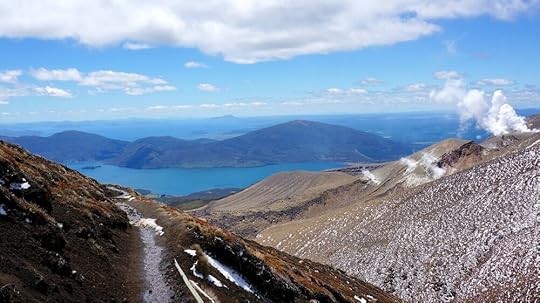
Being called “perhaps the greatest one day walk in the world” lends itself to one major drawback: tons of people show up from all over the planet to do said walk. On ideal summer days, The Crossing can see upwards of 1,500 visitors. I like humans as a general rule, but one of the many appealing aspects of outdoor pursuits is that you often do them away from lots of other people, not to mention your phone, computer and email. This didn’t seem like it would be the case when we arrived at the trailhead around 8:30 a.m. Even knowing the trail’s popularity, the number of people piling out of buses and cars and onto the trail in the early morning light was slightly confronting, especially given the 25-degree (F) temperature and winds gusting above 50 m.p.h. To keep warm, we hit the trail straight away.
After 30 minutes walking alongside a small group of Scandinavian 20-somethings—picture that however you’d like—we skirted past a class of high school students whose teacher decided it would be a great idea to walk in a pack of 80. Even better, she must have thought, let’s do so by occupying the entire width of the trail and move slowly enough to ensure we all finish by winter. Surely, they could have split into smaller groups based on pace for everyone else’s sake, a point I muttered aloud while crawling behind them for 20 minutes. I am ALL for kids getting outside, off the couch and away from video games. I just don’t think they need to do it in front of me…on a trail…in New Zealand...in a group of 80…moving at the pace of the slowest kid in the class.
Anyway, after they finally let us by, the route climbed sharply for 40 minutes through an area more protected from the wind but steep enough to remind our quads that we’d mountain biked for three hours the previous day. A few hundred yards into this steeper section—and for the next three plus hours up over the highest point—the ground was covered in an inch of overnight snow, despite it being early summer in New Zealand.
The steep section plateaud in a field of lava beneath the exploded cone of the South Crater and after a 10-minute walk across a flat, moon-like landscape, the trail continued up the steepest section of the entire trip. For 30 minutes, it ran along a ridge to the highest point of the climb near Red Crater. The snow was slightly deeper and those who decided that running sneakers were a good idea for a 20 km hike across a snow-capped volcano were flailing around like fish. This provided much amusement.
From the top, the view of the surrounding peaks is sensational. A large sign cautions visitors that they are in a hazardous volcanic area. This seemed to be a bit late in the game to be informed of such a detail. Steam vents make the visibility foggy and leave the air stinking of sulfur. Below, the trail dives sharply down a very steep pitch toward the beautiful green Emerald Lakes, the highlight of the Crossing and a photo you see in many New Zealand guidebooks. The lakes fill explosion craters and get their eye-catching colors from dissolved minerals that have washed down from the thermal area near Red Crater. On this day, the contrasting freshly fallen snow framed the lakes. Thick dark volcanic soil made the footing challenging and several people took spills as they made their way down the hill. Again, more amusement ensued.
We labored down the hill through the soft volcanic soil and lunched just beyond the lakes out of the wind. The sun was still shining brightly and it felt as though we were a million miles from anywhere. I love that feeling, unless I’m hungry. Twenty minutes later we commenced the final three hours of the trek. Six hours and 15 minutes after we began, we were in the parking lot paying $30 for a shuttle ride back to our car. Unbeknownst to us, this would be the most dangerous part of the day, as the driver careened down the highway and back up the dirt road, taking corners at a frightening speed in a beat-up van whose best days looked like they might have been in some Beach Boys photo shoot in 1963. To avoid pondering how far my body might land from the vehicle in the event of a crash given that there were no seatbelts and the driver insisted on TURNING AROUND to speak to us, I shifted my thoughts to the cold beer and soft pillow I’d be enjoying in that order (not simultaneously) once back in the booming metropolis of National Park.
In the morning, we swung by the train station, where I purchased a hot chocolate from the pleasant, young lady working in the shop. It was Wednesday and I felt bad for her. She wouldn’t be seeing anyone all day.
